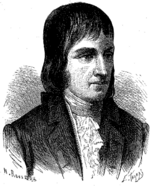Philippe Lebon facts for kids
Quick facts for kids
Philippe Lebon
|
|
|---|---|

Philippe Lebon
|
|
| Born | May 29, 1767 Brachay
|
| Died | December 1, 1804 (aged 37) |
| Nationality | French |
Philippe Lebon (May 29, 1767 – December 1, 1804) was a French engineer. He was born in Brachay, France.
Lebon made important improvements to steam engines. He also found a way to get lighting gas from wood for industrial use. This was a big step for early technology.
Contents
Philippe Lebon's Life and Work
Philippe Lebon's life and inventions have some confusing parts. For a long time, people thought he was killed. This was said to happen in December 1804, just before Napoleon became emperor.
However, official papers from 150 years later tell a different story. These documents show no signs of a crime or injuries on his body. His servant and the person who checked his belongings after he died did not mention anything suspicious.
Lebon's nephew, Joseph Gaudry, only wrote about family rumors in 1856. Letters from Lebon himself show he was sick for weeks before he died. He also did not have much medical help. It seems he died from illness on December 1, 1804, at 10 AM.
The Wood Gas Engine
Philippe Lebon also designed an engine that ran on wood gas. It is not clear if he ever built it. This engine was not the first of its kind.
Unlike some other early engines, it did not compress the air inside its main cylinder. It had three cylinders that worked together. One cylinder compressed air, another compressed gas, and the third was powered by the burning mixture. This design was an early step towards modern engines.
The First Internal Combustion Engine
In 1801, Philippe Lebon invented another important engine. This engine improved on an earlier design by Robert Steele. Lebon's engine used gas from coal. It ignited the gas with an electric spark.
This invention was one of the very first internal combustion engines. An internal combustion engine is where fuel burns inside the engine itself. While Lebon's engine was not very efficient, it was a key invention. Its ideas were later used and improved. Today, internal combustion engines power most modern cars.
See also
 In Spanish: Philippe Lebon para niños
In Spanish: Philippe Lebon para niños

